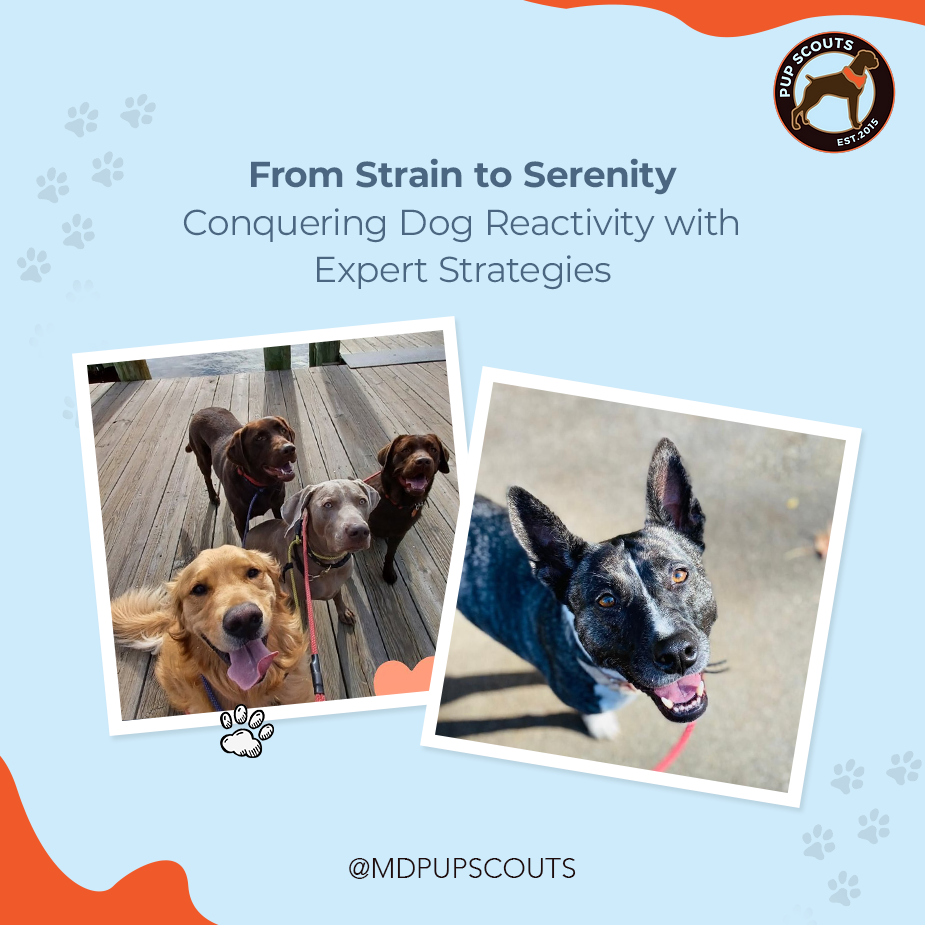Managing Dog Reactivity: Strategies to Transform Walks from Stressful to Successful

Learn the Tips & Tricks to Master Dog Reactivity
Let’s take a look at dog reactivity. There are various reasons as to why a dog may develop reactivity. In addition to the root causes, we must consider how different scenarios may influence reactivity.
A perfect example that comes to mind is when we think of leash reactivity; a lot of the time, when we are working with a dog who has leash reactivity, the dog may be excessively lunging, growling, barking, and snapping at another dog while they are on the leash.
However, if the dog were often off leash and approached another dog, they may be completely fine. Why is this?
Early Influences on Leash Reactivity
Leash reactivity can be influenced when your dog is a puppy. If when your dog was a puppy, it pulled to meet every dog that you saw on the walk, and if we unintentionally allow this behavior, our dog will then develop an excitable association with other dogs and a lot of the time, this manifests into frustration.
As the dog gets older, bigger, and stronger, the display of behavior that they may show when seeing another dog often will cause a bit of worry or panic from us. Now that they are bigger, and we are inclined to restrain them, this excitability bubbles and boils over and manifests into reactivity.
The more your dog practices this behavior, the more it becomes reinforced. Additionally, our newfound panic regarding this behavior only furthers our instincts to pull tightly on the leash, thus reassuring the dog that something is wrong. If your dog is out ahead of you on the walk without having earned that trust and assurance that they will respond to verbal cues and body language, we are essentially setting ourselves up for disaster.
Barrier Frustration and Territorial Aggression
If your dog tends to bark at other dogs behind your fence or perhaps even at the door, this is what we call barrier frustration, or in other cases, it could be territorial aggression.
Once again, the formula is the same. Fido sees something that he wants to get to so that he can either A. say hi, or B. go away. The process of being restrained or prevented from achieving his goal causes the spiraling out and explosive outburst.
Psychological and Emotional Factors
Sometimes reactivity is caused by a neurological disorder; other times, we may also have to consider that our dog doesn’t like other dogs. Suppose we have a dog that struggles with insecurity which commonly develops from a lack of leadership and guidance from ourselves. In that case, they learn that the barking either makes the other dog go away or influences us to remove them from the unwanted situation.
Clients often say, “They got along great with other dogs when they were a puppy. I don’t know what happened?” As your dog ages and matures, it is not unusual for its taste to change. I know many people who don’t like other people! And that is completely okay.
Strategies for Managing Reactivity
So, what do we do about it?
Building Engagement and Attention
In my experience, the manifestation of reactivity starts way before encountering that other dog on the walk. Suppose your dog shows little to no engagement with you while walking; your chances of getting their attention when it counts will be much harder. Other things to look out for are if your dog is constantly sniffing the ground and pulling you in different directions to get to a specific bush. Of course, your dog will sniff, but this behavior is realistically categorized under prey drive.
Essentially when your dog is scenting, it is not that different than when they are hunting. So, it only makes sense that if they are constantly in a state of prey drive rather than in a pack drive when they see an unknown trigger, they are already aroused and ready to pounce.
Lastly, if your puppy has a habit of peeing every 5 to 10 minutes, it is not likely that they have a bladder problem. It is often called “marking” and lets other dogs know that “this is my spot”, especially if a little digging follows it.
Interrupting the Build and Shaping Behavior
Teaching your dog not to explode when seeing another dog will have to start by first training your dog to pay attention to you. If you head out for your walk and your dog is constantly sniffing around and looking for things to do, they are likely trying to create a job for themselves. Your job is to communicate to Fido that his only job on the walk is to walk nicely with you, stay engaged, and trust that you will let him know what is and isn’t appropriate.
Try to enforce what we discussed in our last two blogs concerning the loose leash walking 180-degree turns and implementing your break command so that now you are letting your pup know when it is okay for them to go and sniff in a safe and secure environment.
Lastly, when it comes to reactivity, we have to acknowledge that you will be able to see your dog starting to “load” or “build” when they clock another dog.
Let’s say that Fido sees another dog at the end of the block; you may notice that his head gets lower to the ground in a stalking fashion, his ears will more than likely be erect, and his mouth may go from panting to closed. This is a great time to interrupt the build.
You can draw backwards and encourage your dog to come to you. “Fido, Come!” This drawing back will encourage your dog to turn around and follow you, and if he doesn’t immediately turn around, use your leash to reel him in. You can also give a little leash pop to disrupt the build paired with a “leave it” command. Or you can use your leg closest to the dog to turn into them.
Consistency and Patience
Be mindful that whichever way your dogs’ eyes are focused will determine their arousal level. So, if you can effectively turn their eyes away from the dog and back onto you, you will be in much better shape. But these things take time.
If you can effectively execute a pattern of disrupting the undesirable behavior, redirecting to a preferred desirable behavior, and reinforcing that desired desirable behavior, then over time, your dog will begin to understand “Well, when I perform this behavior it is discouraged, but when I do this one it is rewarded”, and they will start to choose to do the desirable behavior instead.
We tend to replay these instances in our head, so we naturally expect the dog to fail, choke up on our leash, and dilute our ability to communicate what we want effectively. If you are severely struggling with reactivity, seek professional help!

We Know the Art of Tailored Canine Obedience Training
Tailored Canine Obedience Training at MD Pup Scouts
At MD Pup Scouts, our commitment to dog obedience training is unwavering. We understand that each dog possesses unique traits and characteristics.
Whether a dog exudes insecurity, fearfulness, anxiety, or an exuberantly joyful demeanor, our instructional methodology is meticulously tailored to facilitate optimal learning.
Our approach delves deep into the intricate realm of dog psychology, ensuring a comprehensive understanding of our furry companions. Through our professionals’ expertise, a distinct rapport is cultivated, enabling a profound bond to develop.
Contact us today! Prepare for enriching walks, insightful learning, and meaningful companionship with your MD Pup Scouts’ professional dog training service.

Managing Dog Reactivity: Strategies to Transform Walks from Stressful to Successful
Let’s take a look at dog reactivity. There are various reasons as to why a dog may develop reactivity. In addition to the root causes, we must consider how different scenarios may influence reactivity. A perfect example that comes to mind is when we think of leash reactivity; a lot of the time, when we […]

